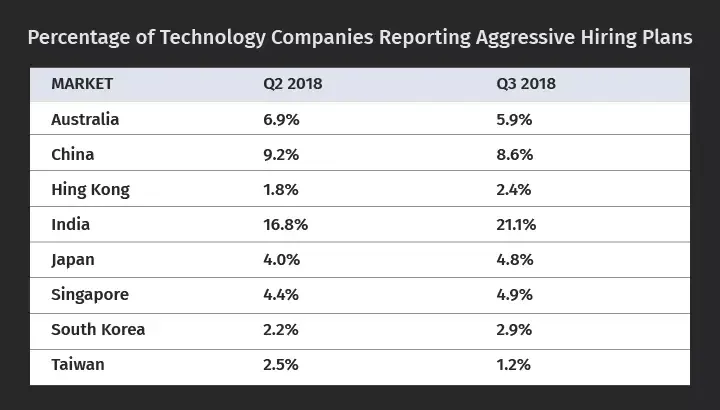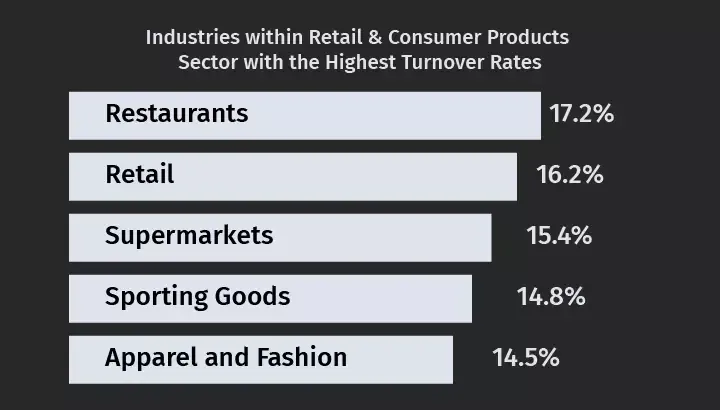Taux de rotation des employés : Les causes, l'impact et les moyens de le réduire
Un taux élevé de rotation du personnel peut perturber la productivité, augmenter les coûts d'embauche et affaiblir le moral des employés.
Sur cette page
- Qu'est-ce que la rotation du personnel ?
- How to calculate employee turnover rate
- Average employee turnover rate by industry
- Que signifie réellement une rotation élevée du personnel ?
- Causes de la rotation du personnel sur le lieu de travail
- Comment réduire la rotation du personnel ?
- Measuring the true cost of employee turnover
- Reducing employee turnover with Empuls
- Bottomline
The employee turnover rate reflects your company’s ability to retain talent. While some turnover is expected, excessive departures lead to productivity loss, hiring costs, and low morale. With job openings dropping to 8.7 million and separations holding at 5.6 million, businesses must focus on retention strategies.
A healthy turnover rate is around 10% or less, yet 75% of employers struggle to attract and retain top talent. High-performance companies keep top employees with an annual high-performer turnover rate as low as 3% or even zero.
But what drives employees to leave? From poor workplace culture to lack of career growth and work-life balance, the causes vary—but the impact is always significant.
This article explores the causes of employee turnover, how to measure it, and how to reduce employee turnover with practical strategies.
Qu'est-ce que la rotation du personnel ?
Employee turnover is the number of employees who leave your company over a specific period, typically one year. Although employee turnover usually covers the total number of employees who leave a company, it can also be calculated per department or unit.
Employee turnover doesn’t just refer to employees leaving voluntarily from the company. For example, when an employee is fired due to poor performance or a bad attitude, that counts as employee turnover.
Only, it is involuntary. Some employee turnover is, therefore, inevitable. However, a sudden spike in employee turnover is not because it can be reflective of the bad workplace environment that prompts employees to leave in the first place.
Les entreprises qui connaissent un taux de rotation élevé sont considérées comme de mauvais endroits où travailler. Par conséquent, les entreprises ayant une mauvaise réputation ont du mal à attirer les meilleurs talents.
How to calculate employee turnover rate
Knowing if your business has a high employee turnover rate is crucial—it’s a key indicator of workplace culture and retention challenges. If your turnover is significantly higher than that of your competitors, you may lose the battle for top talent. Here’s how to calculate it accurately.
1.Turnover Rate Formula (SHRM Recommended):
Turnover Rate=(Average Number of Employees Number of Separations)×100
Identify employee departures: Count all separations (voluntary and involuntary) over a specific period.
Determine the average workforce: Add the number of employees at the start and end of the period, then divide by two.
Apply the formula: Divide the number of departures by the average number of employees and multiply by 100 to get the percentage.
Example employee turnover calculation:
Employees at the start: 200
Employees at the end: 180Employees who left: 20
Average number of employees: (200 + 180) / 2 = 190
Turnover rate: (20 / 190) × 100 = 10.5%
Turnover calculations aren’t always straightforward. You must decide how to account for part-time employees, temporary workers, and employees on leave. The SHRM Turnover Calculation Spreadsheet can simplify this process by ensuring accurate workforce calculations.
Why industry benchmarking matters
Your turnover rate doesn’t mean much unless you compare it to competitors. A "low" turnover rate might still exceed industry standards, signaling a retention problem. Researching average employee turnover rate by industry and location helps businesses understand where they stand and what improvements are needed.
Why employee turnover is a growing concern
Employee retention remains a challenge worldwide. Studies show that half of U.S. employees have considered leaving their current jobs, making it a competitive labor market. Businesses that fail to address turnover risk losing top talent to companies with better workplace culture and engagement strategies.
Tracking and analyzing turnover regularly is essential to improving employee satisfaction and reducing unnecessary attrition—ensuring your company remains a competitive employer of choice.
Average employee turnover rate by industry
Now that you know how to calculate the employee turnover rate, your next question is, what constitutes a low and high turnover rate? The answer will depend on your industry.
It’s difficult to give an ideal employee turnover rate because industry-specific factors also affect employee turnover. What I can give you, though, are the employee turnover jobs and high employee turnover industries.
Plongeons dans le vif du sujet :
1. Tech
Tech has had the highest employee turnover rate in recent years. In 2017, it had a 13.2% turnover, according to a LinkedIn study. That’s 0.2% more than the employee turnover rate for retail (more on this later). In previous years, retail had consistently been at the top of the list of industries with the highest employee turnover.
Within the tech industry, some industries have shown the highest turnover rates:
There are specific high-turnover jobs, too. For example, the job of user experience and designer had a turnover rate of 23.3%. This was followed by the data analyst post and the embedded software engineer post, with 21.7% each. However, the high employee turnover rates in the technology industry, in general, may have more to do with staff competition.
Comme la concurrence dans le secteur s'intensifie pour des ressources rares, les entreprises offrent des salaires et des avantages plus compétitifs pour rivaliser, ce qui incite certains employés à quitter le navire lorsqu'ils trouvent de meilleures opportunités.

The table above from the Radford Global Technology Survey Quarterly Workforce Trends Report shows that, in particular, there has been a spike in the number of companies looking to hire aggressively, particularly in India, where the technology sector is booming.
En d'autres termes, même si le taux de rotation est élevé dans certains domaines de la technologie, ces employés peuvent toujours trouver un emploi dans l'industrie technologique.
2. Industrie de la vente au détail et des produits de consommation
Historically, the retail and consumer products industry has had a high employee turnover rate. According to the LinkedIn survey, within the retail sector, restaurants had the highest turnover rate, at 17.2%:

Au sein de l'industrie du commerce de détail, le personnel de vente au détail affichait le taux de roulement le plus élevé, soit 19,3 %, suivi des professionnels des services alimentaires, à 17,6 %, et des professionnels de l'accueil, à 17,0 %.
Although it’s hard to say the main reasons for employee turnover in the industry, the fact that the jobs with the highest turnover are low-level and seasonal may explain a lot. Also, the rise of eCommerce in retail means that fewer people are needed in-store.
This is because many traditional retail functions have been digitized and automated. Online shopping, self-checkout kiosks, and automated inventory management through distribution ERP software have reduced the need for as many in-store staff.
3. Industrie des médias et du divertissement
The employee turnover rates in the media and entertainment sectors are constant.
Qu'il s'agisse de journaux, de médias en ligne, de sports ou de voyages et de tourisme, le taux de rotation des employés est fondamentalement le même selon LinkedIn : de 13 % à 13,2 %.
On ne peut pas en dire autant des emplois dans le secteur du cinéma. Les animateurs ont le taux de rotation le plus élevé, à 25,6 %, suivis des artistes 3D, à 22,3 %. Les spécialistes du marketing arrivent en troisième position, avec un taux de rotation des employés de 19,8 %.
Les emplois à forte rotation basés sur les données sont pour la plupart basés sur des projets (ou ont un début et une fin clairs, en fonction de la durée du tournage d'un film, par exemple).
Le taux de rotation élevé pourrait expliquer l'exode des employés. Si tel est le cas, ces statistiques doivent être traitées avec une certaine prudence, car il ne s'agit pas d'une mesure précise de la rotation des employés.
Que signifie réellement une rotation élevée du personnel ?
Il existe de très nombreuses raisons pour lesquelles les employés quittent votre organisation à un rythme élevé - cela peut être différent pour chaque entreprise. Mais il existe quelques facteurs communs que vous voudrez examiner et qui sont souvent à l'origine du départ des employés.
1. Faible rémunération ou avantages sociaux
Si vos employés travaillent aussi dur que vos concurrents, mais qu'ils n'obtiennent pas le même niveau de rémunération ou d'avantages, c'est une raison importante pour laquelle ils pourraient partir. Et avec la popularité de sites tels que Glassdoor, les employés d'aujourd'hui ont une bonne idée de ce que gagnent leurs pairs dans d'autres organisations.
Après tout, les employés acceptent un emploi pour de nombreuses raisons, mais la plus importante est de gagner de l'argent pour subvenir à leurs besoins et à ceux de leur famille. S'ils n'ont pas l'impression de pouvoir le faire avec vous ou s'ils se sentent mieux ailleurs, ils sont plus susceptibles de partir.
2. Culture négative sur le lieu de travail
Are your employees stressed out, overloaded with work, unappreciated, or subject to too much unhealthy competition? The culture of your workplace has a significant impact on employee retention.
Si les employés ont le sentiment que votre organisation montre, à travers la culture du lieu de travail, que vous ne vous souciez pas d'eux en tant que personnes, ils vont probablement se diriger vers la sortie rapidement. Cela peut signifier une culture de surcharge de travail, de sous-appréciation et une culture de mauvaises limites, de sorte que les employés travaillent à toute heure ou une culture de comportement désagréable ou nuisible.
Les employés passent la majeure partie de leur semaine au travail. Avez-vous créé une culture de soutien où les gens peuvent donner le meilleur d'eux-mêmes ou une culture où ils ont hâte de sortir à la fin de la journée ?
3. Mauvaises perspectives de carrière
Vous avez beau avoir des salaires compétitifs et une excellente culture d'entreprise, vous remarquez que les employés partent plus souvent que vous ne le souhaiteriez - qu'est-ce qui se passe ? Il peut s'agir d'un manque d'opportunités de carrière. Si les employés n'ont pas l'impression de pouvoir réussir à long terme dans votre entreprise, ce n'est pas très encourageant.
Ils veulent avoir la possibilité d'acquérir de nouvelles compétences, de relever de nouveaux défis et de faire évoluer leur carrière. Cela ne signifie pas que vous devez promouvoir chaque employé chaque année - ce n'est pas une attente raisonnable.
Mais cela peut aider à examiner de près le type de plans et d'opportunités de développement de carrière que vous offrez à vos employés - y a-t-il place à l'amélioration, en particulier pour vos talents les plus prometteurs ? En les aidant à voir un avenir clair et à planifier pour y parvenir, vous pouvez encourager les employés talentueux à rester et à continuer à contribuer à votre entreprise.
4. Quand le roulement est sain
Cela étant dit, le roulement du personnel n'est pas toujours mauvais ! Un taux de rotation sain apporte du sang neuf et des idées nouvelles à votre organisation. Les nouvelles recrues peuvent apporter de nouvelles façons d'aborder les anciens problèmes et améliorer le fonctionnement de votre organisation. Vous ne voulez pas que les choses s'enlisent dans le monde en évolution rapide d'aujourd'hui, alors ne visez pas un taux de roulement de zéro.
De plus, vous souhaitez parfois que les employés qui ne sont pas bien adaptés à leur rôle ou à la culture de votre entreprise se retirent de votre organisation et trouvent un endroit ou un rôle qui leur convient mieux. Ce type de roulement est sain et devrait parfois se produire au lieu de retenir des personnes qui ne fonctionnent pas.
En bref, n'essayez pas de vous débarrasser de la rotation du personnel, mais assurez-vous qu'elle reste à un niveau sain et qu'elle se produit pour les bonnes raisons.

Build a Culture Employees Don’t Want to Leave
Employees leave when they feel unappreciated. Empuls makes recognition, rewards, and workplace connections effortless, increasing retention and job satisfaction.
Causes de la rotation du personnel sur le lieu de travail
I’ve mentioned that some employee turnover rate is inevitable. When employees retire, for example, that’s not within the company’s control. The same can be said of employees deciding to shift careers.
There are, however, reasons for employee turnover that companies can do something about. In this section, let’s look at those:
1. Manque de croissance
No one wants to be stuck in the same old job, doing the same old routine. In fact, according to Business2Community, career development opportunities rank third among the non-monetary company offers that make employees stay.
Si vous voulez que vos employés s'investissent à long terme, assurez-vous de leur faire comprendre dès le départ qu'ils ont un avenir dans l'entreprise s'ils travaillent dur.
Always remember, your employees are not robots who have no plans. People have professional goals and want to advance in their chosen careers. If the job they have now isn’t helping them attain those goals, then leaving won’t be as hard.
2. Trop de travail
Si vous demandez aux anciens employés d'entreprises à fort taux de rotation pourquoi ils sont partis, l'excès de travail est probablement l'une des raisons qu'ils vous donneront. Tout le monde aime un travail qui paie les factures, mais pas s'il entraîne du stress et, pire, des maladies.
Too much work results in burnout and that, according to the Harvard Business Review, costs about $125 billion to $190 billion a year in healthcare spending in the US. The real costs on the company, however, can be even greater, with low productivity as a result of lost talent.
In other words, all companies should respect their employees’ time, too. There’s a reason employees use an employee time clock app to log in and out of work. Once the clock strikes 5 p.m., they can basically do whatever they want. But that also means they’d have to be in the office at exactly 9 a.m. the following day.
3. Manque de reconnaissance
Giving credit where credit is due is key to employee retention. According to The Balance Careers, 55% of employees believe employee recognition will make them feel valued. Of the study's respondents, 58% also said employee recognition will improve employee engagement in the company, a crucial element for employee retention.
Il y a ensuite la relation entre la reconnaissance et la productivité. Selon Gallup, 69 % des personnes interrogées travailleront davantage si elles ont le sentiment que leurs efforts sont reconnus. Cela se traduit par une augmentation de la productivité globale de l'entreprise et une hausse des bénéfices.
4. Peu d'occasions de décider
Managers should manage their teams, but that doesn’t mean they should “suffocate” them. Of course, I don’t mean that in the literal sense of the word. I meant they shouldn’t micromanage employees to the point that they can no longer do anything without the manager’s approval.
If employees have little opportunity to decide, morale is affected badly. This is because they become frustrated with the loss of autonomy and lose the desire to go the extra mile when given a task. And when there’s low morale, there’s low productivity.
When employees are given little opportunity to decide, they also become too dependent on the manager; they no longer think outside the box and grow.
5. Mauvaise sélection des employés
Employees sometimes leave companies because it’s just in their DNA to do that. Although there is nothing companies can do about a person's DNA, they can still control the people they hire. HR should hire, not just the candidate with the skills for the job.
Il doit également examiner l'attitude et les valeurs du candidat. S'ils ne correspondent pas aux valeurs de l'entreprise, même si le candidat est le meilleur pour le poste du point de vue des compétences, autant choisir le meilleur suivant qui sera probablement heureux dans votre bureau. Car lorsque cette personne est heureuse, elle a plus de chances de rester.
Comment réduire la rotation du personnel ?
Maintenant que vous connaissez les principales raisons du roulement du personnel, discutons des stratégies permettant de réduire le roulement du personnel et d'empêcher vos employés de partir :
1. Assurer un parcours de carrière clair pour les employés
As the HR, you should also work closely with the company managers to identify employees with potential. Once identified, their immediate supervisor should guide them so they can have the necessary skills to grow. The idea is to help them comply with the requirements needed to climb the corporate ladder.
On your part, provide managers and employees with potential the necessary support they need. You can, for example, sponsor training and seminars. Organize events with senior company officials as resource speakers and employees as the audience, too.
This way, your employees will know more about how the management started out in the organization and how, with hard work, they grew and reach success.
2. Ensure good work-life balance
Ne faites pas tout pour travailler avec vos employés. Rappelez-leur de prendre leur pause déjeuner. Emmenez-les faire des sorties d'entreprise de temps en temps. Organisez des événements sociaux au bureau. Faites-leur comprendre que si l'entreprise valorise la productivité, ce n'est pas au détriment de leur santé.
Make sure you monitor the workload given to employees, too. If a team member is bogged down with work, some of the tasks can be assigned to other members of the team who can do it just as well. Delegate, so not one member of the team becomes overworked and becomes so frustrated the person leaves.
3. Improve employee engagement through communication
Lack of communication and transparency fuels disengagement, making employees feel disconnected from the company’s mission. Empuls’ social intranet and survey tools help bridge this gap by creating an interactive, open communication space where employees can share feedback, participate in discussions, and stay informed.
Regular pulse surveys provide real-time insights into employee sentiment, helping HR leaders address concerns before they escalate into turnover. When employees feel heard and involved, they are more engaged and less likely to seek opportunities elsewhere. A connected workforce is a retained workforce.
4. Recognize and reward employees from time to time
Employees are more likely to stay when they feel valued for their contributions. Regular appreciation—whether through verbal recognition, bonuses, or career growth opportunities—creates a positive work environment where employees remain motivated and engaged. Recognizing achievements not only boosts morale but also reinforces company values and encourages high performance.
This is where Empuls helps organizations build a culture of recognition with real-time appreciation, personalized rewards, and milestone celebrations. With features like peer-to-peer recognition, automated incentives, and service anniversary rewards, Empuls ensures employees feel acknowledged at every stage of their journey. By making recognition a seamless part of daily workflows, businesses can enhance engagement, strengthen loyalty, and significantly reduce turnover.
5. Give credit where credit is due
It’s always a good idea to recognize hard work. When companies do this, they make employees feel valued and motivate employees to work even harder. As the HR, you can, for example, organize a special recognition day for employees who stood out during a given period.
Par exemple, reconnaissez, lors d'un événement organisé dans toute l'entreprise, le vendeur qui a vendu le plus de produits au cours du premier trimestre de l'année. Ou donnez des congés annuels supplémentaires à cette personne qui n'était jamais en retard au travail. Vous pouvez également offrir des récompenses monétaires si vous le pouvez. Soyez créatif.
Look for trends in employee rewards programs and be inspired. If you give credit where credit is due, you will keep your employees happy and engaged. And leaving the company for them will be out of the question.
6. Tell managers not to micromanage
Don’t get me wrong. Hands-on managers are great. What companies don’t want, though, are managers who are overly hands-on, and their co-workers can’t get anything done without them. As the HR, brief your managers on how the company would like things done.
Although team management is necessary, it shouldn’t be to the point the entire workflow gets bogged down because the managers need to approve everything. Tell them to give employees some leeway to decide things. This way, employees will feel they have something to contribute. And they develop their decision-making skills.
7. Do the selection process right
Don’t just breeze through the selection process when you’re looking to fill a position in the company. The selection process is there, so companies will be spared from hiring candidates who are not a good fit in the company. So take your time and conduct the interview properly with an effective talent management process.
Ask relevant questions. You want to gauge the candidate’s skills AND the person’s attitude and personality. Hiring someone just because that person was the first one with the skills required to apply for the job is never a good idea. You have to wait for the right person. Not force one candidate to be the right person so that you can announce the position has been filled.
8. Offer competitive compensation and benefits
Salary plays a key role in retention, but it’s not just about offering a competitive base pay. Employees today expect comprehensive benefits that go beyond a paycheck. Companies should provide healthcare plans, wellness perks, performance-based bonuses, and tax-free fringe benefits to enhance financial security and job satisfaction.
Additionally, benefits like tuition reimbursement, childcare assistance, and flexible spending accounts make employees feel valued and supported, increasing their commitment to the organization. Employers who invest in well-rounded compensation packages create a workplace where employees feel financially stable and motivated to stay.
Measuring the true cost of employee turnover
Demandez à n'importe quel employé, professionnel des RH ou gourou des affaires, et il vous dira que, oui, la rotation du personnel est mauvaise. Bien sûr, c'est logique : les employés qui quittent votre entreprise ne sont pas un bon signe !
Vous n'avez pas besoin d'un MBA pour vous le dire. Mais peu de gens connaissent le coût réel de la rotation du personnel. Et c'est un problème, car la rotation du personnel coûte aux entreprises beaucoup plus qu'elles ne le savent.
Si vous ne savez pas ce que vous coûte un taux de rotation trop élevé, vous ne comprendrez pas l'urgence de régler le problème.
Examinons donc les coûts réels d'un faible taux de rétention pour votre résultat net.
1. Le coût financier
Le coût du turnover le plus accessible à calculer est le tribut financier qu'il représente pour votre entreprise. Les employés sont à terme un atout pour votre entreprise, mais au début de leur carrière chez vous, ils ont un coût.
Le recrutement, l'embauche et la formation entraînent tous des coûts monétaires - et vous ne pouvez pas contourner ces dépenses. De nombreuses données sont disponibles sur le coût du remplacement d'un seul employé qui part, en fonction de son niveau et de son ancienneté dans son poste.
So how much does it cost to replace an employee who leaves in real dollars? There are many ways to estimate the cost. Still, a good benchmark is 50% of the salary for entry-level employees, 125% of the salary for mid-level employees, and over 200% of the salary for a senior executive. That’s a lot. That’s tens of thousands of dollars, at the minimum, you need to spend every time a single employee leaves your company.
Bien entendu, ce taux varie selon le secteur et l'entreprise - vous pouvez calculer le coût exact du chiffre d'affaires de votre entreprise à l'aide de cette feuille de calcul du SHRM. Mais ce coût fiscal, aussi étonnant soit-il, n'est pas le seul coût que vous supportez à chaque départ.
2.The knowledge cost
Chaque année où un employé travaille pour votre entreprise, il acquiert davantage de connaissances. Il apprend des choses comme les processus et les procédures nécessaires pour que les choses soient faites de la manière dont votre entreprise les fait.
Ils acquièrent de l'expérience en travaillant avec vos clients et vos consommateurs et établissent des relations avec eux. Ils établissent des relations entre eux. Ils passent du stade où ils ont besoin de formation à celui où ils sont capables de former d'autres employés. Ils accèdent à des rôles de gestion. Ils augmentent leurs précieuses connaissances institutionnelles et sectorielles.
Quand ils partent, tout cela part aussi. Contrairement aux outils tels que les imprimantes, les chaises de bureau ou le réfrigérateur de votre salle de repos, les employés sont un actif qui s'apprécie. Ils gagnent en valeur chaque année où ils restent dans votre entreprise, grâce à tout ce qu'ils apprennent et appliquent chaque jour.
So, if you’re regularly losing employees to competitors after just two or three years, you’re also losing that long-term learning employees are absorbing and passing onto newer hires too. You also lose the valuable relationships that your best employees develop with your customers.
Vous pourriez finir par perdre un ou plusieurs clients en même temps qu'un employé - et cela peut être dévastateur pour votre entreprise. Vous ne pouvez pas vous permettre de laisser filer vos meilleurs éléments pour des raisons évitables.
3.The morale cost
Soyons francs : si vos employés quittent régulièrement votre entreprise au bout de quelques années - ou de quelques mois -, il y a probablement quelque chose qui ne va pas du tout dans l'expérience de vos employés. Il n'est pas facile de renforcer le moral des employés lorsque ceux-ci quittent régulièrement l'entreprise.
Un taux élevé de rotation du personnel peut être à la fois une cause et un symptôme d'un manque d'engagement et de moral des employés. Si les employés n'aiment pas venir travailler tous les jours et ne se sentent pas engagés dans leur travail, ils sont plus susceptibles de partir.
Et nous avons probablement tous fait l'expérience de faire partie d'une équipe dont les membres partent les uns après les autres - et cela commence à être assez inquiétant.
Les employés qui restent doivent prendre le relais, ils pleurent les relations perdues avec le collègue disparu et commencent à se demander s'ils ne devraient pas partir eux aussi. Cela peut entraîner un cercle vicieux de turnover toujours plus important, jusqu'à ce qu'il ne vous reste plus que les employés les plus récents et les moins expérimentés qui n'ont nulle part où aller.
Reducing employee turnover with Empuls

High employee turnover doesn’t just impact recruitment costs—it affects team morale, productivity, and overall company culture. Employees don’t leave just for better pay; they leave when they feel undervalued, disconnected, or unheard. Empuls helps businesses create an environment where employees feel motivated to stay.
Instead of reacting when employees resign, Empuls enables companies to proactively engage and retain talent through:
- Recognition & rewards: A culture of appreciation fosters loyalty. With Empuls, employees receive timely recognition for their contributions, making them feel valued.
- Real-time feedback & surveys: Understanding what employees need before disengagement sets in is key. Empuls’ engagement surveys uncover hidden concerns and provide actionable insights.
- Social intranet for connection: A connected workplace reduces isolation and strengthens company culture. Empuls’ social intranet promotes open communication and collaboration, even in remote teams.
- Personalized employee perks: Offering benefits that align with employee preferences—like wellness programs, learning opportunities, or milestone rewards—enhances job satisfaction and retention.
When employees feel heard, appreciated, and engaged, they choose to grow within the company rather than look elsewhere. Empuls provides the right tools to build a workplace where employees stay, thrive, and contribute to long-term success.
Bottomline
Personne ne pense que des taux élevés de rotation du personnel sont bons pour les affaires. Mais tant que vous ne saurez pas vraiment combien chaque employé qui part coûte à votre entreprise en termes de recrutement et de formation, de perte de connaissances institutionnelles et de moral de l'équipe, vous ne pourrez pas commencer à élaborer des solutions efficaces. La bonne - et la mauvaise - nouvelle ?
La plupart des mouvements de personnel peuvent être évités. Une fois que vous avez calculé le coût réel de la perte d'employés, vous pouvez commencer à élaborer des stratégies pour les retenir. Vous serez alors sur la voie de la création d'une entreprise durable et prospère pour laquelle vos employés aiment travailler.













